________________
VAISHALİ RESEARCH BULLETIN NO.3
The Brhat kalpasūtra Bhas ya26 is a valuable source for the study of different types of upper and lower garments that were used by the Nigganthinis or nuns. Their lower garments consisted of uggahanantaga or avagraha, pafta, addhoruga or ardhoruka, calanika, abbhintaraniyamsini or cntaranivasant and bahiniyam sint or bahimivasint. According to Motichandra, 27 uggahan antaga or avagraha was a piece of cloth to cover the private parts of the body but J.C. Jain 28 has identified it with a boat-shaped garment He says that it was broad in the middle and thin at the sides, and was made of soft cloth. The Patta29 as the name signifies was a cloth used as a waistbelt and was fastened round the waist to hold the lower garment. It was four fingers in width. Jain also accepts that it was a waistcloth but adds that it covered both the ends of uggahanant agã and was like a wrestler's tight shorts, now known as janghiya. The addhoruga or ardhoruka was something like a langota30 but Jain says81 that it was worn over ugga hanantaga and Patta covering the waist. Its shape was after the wrestler's style and was firmly tied on both the sides over breasts. If uggahanantaga or avagraha be identified with the modern petticoat then ardharuka or ardhoruka was in all probability a saari-like garment and not like shorts.32* The calanika was similar to addhoruga in its nature and reached half way down to the thighs but Jain 33 suggests that it was an unsewn garment covering down to the knees. According to him it was worn after the manner of bamboo top dancers. The abbhintaraniyamsiņi or ant aranivasani was like calanika but it was used only at the time of dressing the body to avoid nakedness. But Jain says that it covered from the waist down to half length of the thighs,34 The bahini yamsini or bahirnivasint was something like sadi and it was worn down to the ankle's length.35 It was ti a string or waist-belt.
The upper garments 86 of the nuns compised of kañcuk, ukkacci or aupakaksiki, vegacchiya or vaikasika, sanghata and kehandhakaml or skanhakarani.
26. Ibid., 4.4084-85, 4087-90. 27. JISOA, XII. p. 34. 28. Jain, J.C., Life in Ancient India as Depicted in the Jain Canons, p. 132. 29. Sahay, S.N., Indian Costume, Coiffure and Ornament, p. 44;
Jain, J.C., Life in Ancient India as De picted in the Jain Canons, p. 132. 30. Sahay, S.N., Indian Costume, Coiffure and Ornament, p. 44. 31. Jain, J.C., Life in Ancient India as Depicted in the Jain Canons, p. 132. 32. Sahay, S.N., Indian Costume, Coiffure and Ornament, p. 44. 33. Jain, J.C., Life in Ancient India as Depicted in the Jain Canons, p. 132. *. Otymologically a hip garment covering half of the thighs. cf. art रुकसंवीतविशालजघनस्थलाम् ।
myta qe xx-82. 34. Ibid., p.134. 35.7ISOA, XII. 1940. p. 34. 36. Bphatklpasūtra Bhas ya, 4.4094-90.
Jain Education International
For Private & Personal Use Only
www.jainelibrary.org




